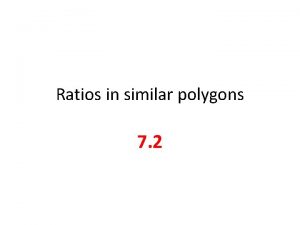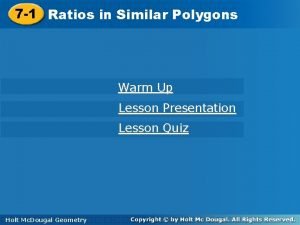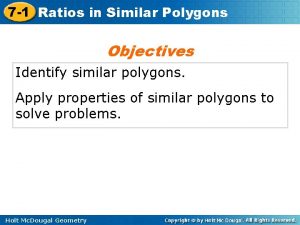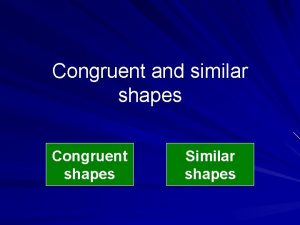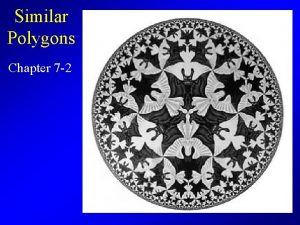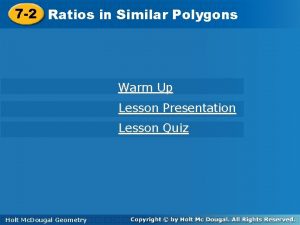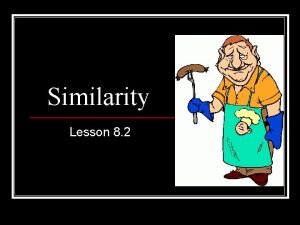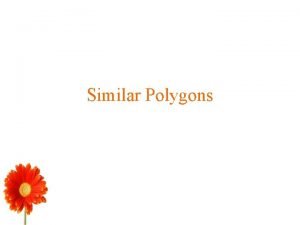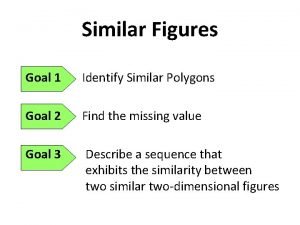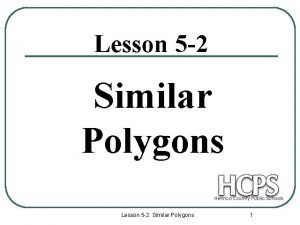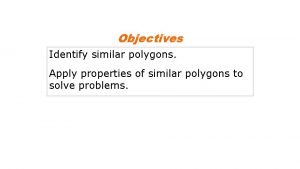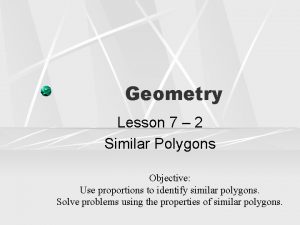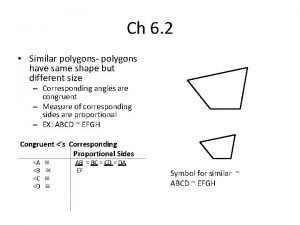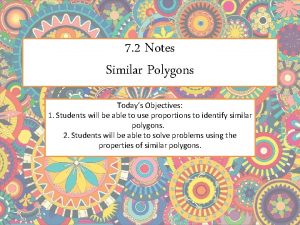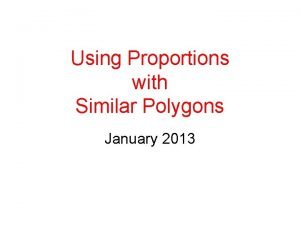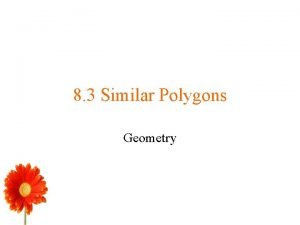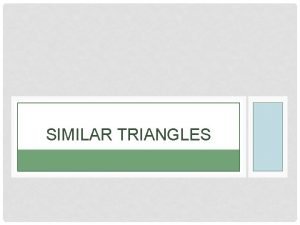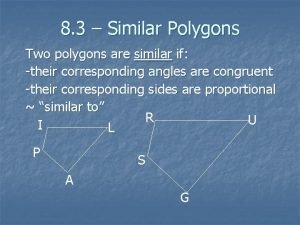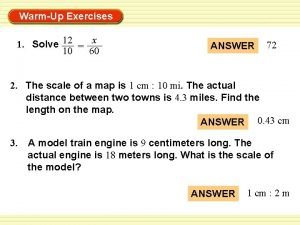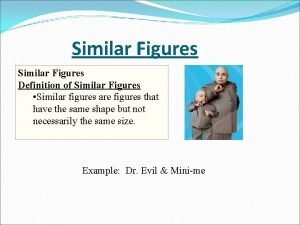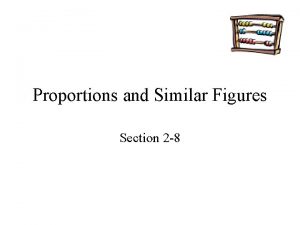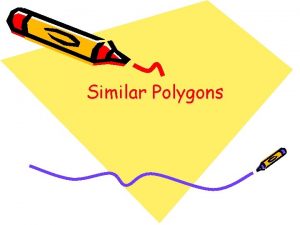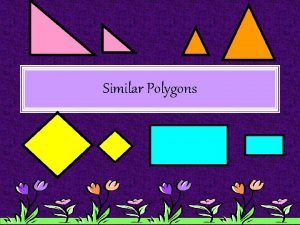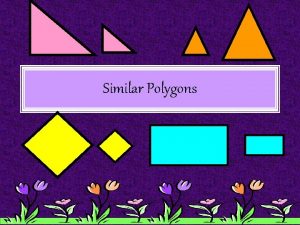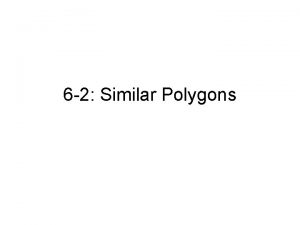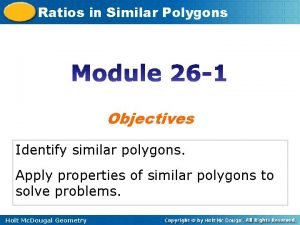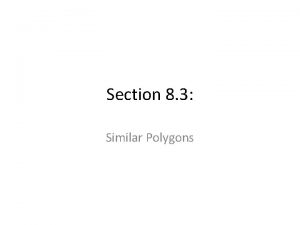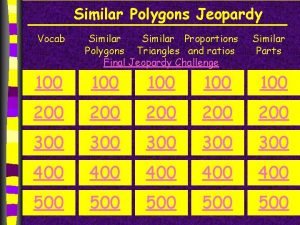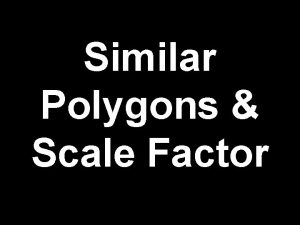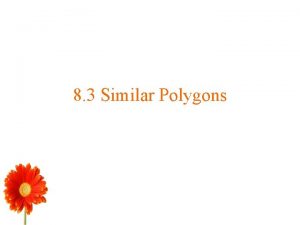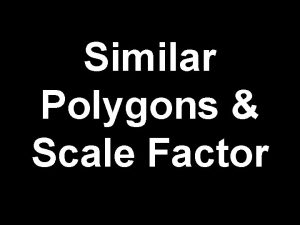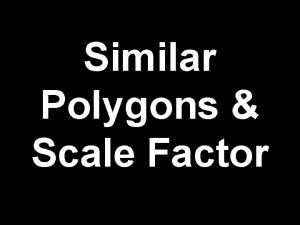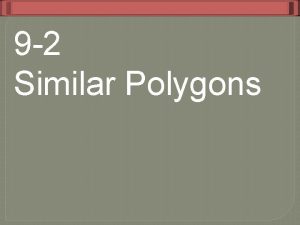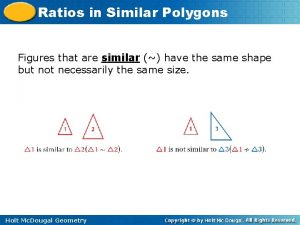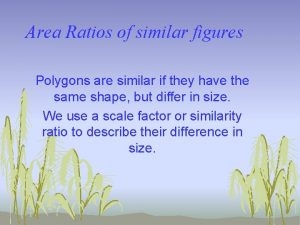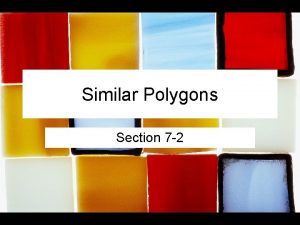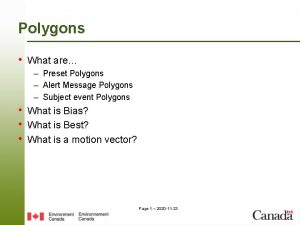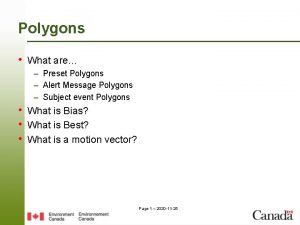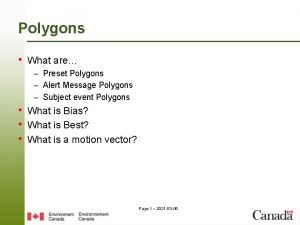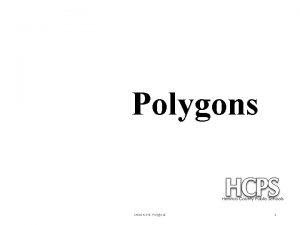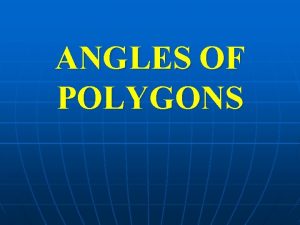CHAPTER 7 SIMILAR POLYGONS SECTION 7 1 Ratios




























- Slides: 28

CHAPTER 7 SIMILAR POLYGONS

SECTION 7 -1 Ratios and Proportions

RATIO – a comparison of two numbers, a and b, represented in one of the following ways: a: b a or a to b b

EQUIVALENT RATIOS – two ratios that can both be named by the same fraction. 4: 8 and 7 : 14

PROPORTION – is an equation that states that two ratios are equivalent. a: b=c: d a=c b d

EXTREMES – the first and last terms a : b= c : d a and d are extremes

MEANS – the second and third terms a: b=c: d b and c are means

CROSS PRODUCTS – the product of the extremes equals the product of the means. ad= bc

SECTION 7 -2 Properties of Proportions

TERMS – the four numbers a, b, c, and d that are related in the proportion.

Properties of Proportions a/b = c/d is equivalent to: a) ad = bc b) a/c = b/d c) b/a = d/c d) (a + b)/b = (c + d)/d 2. If a/b = c/d = e/f = …, then (a+c+e+…)/(b+d+f+…) = a/b = … 1.

SECTION 7 -3 Similar Polygons

SCALE DRAWING – is a representation of a real object. SCALE – is the ratio of the size of the drawing to the actual size.

SIMILAR – figures that have the same shape

CORRESPONDING ANGLES – angles in the same position in congruent or similar polygons.

CORRESPONDING SIDES – sides in the same position in congruent or similar polygons.

SIMILAR POLYGONS – figures having all corresponding angles congruent and the measures of all corresponding sides are in the same proportion. The symbol for similarity is

Scale Factor - The ratio of the lengths of two corresponding sides

SECTION 7 -4 A Postulate for Similar Triangles

AA Similarity n If two angles of one triangle are congruent to two angles of another triangle, then the triangles are similar.

SECTION 7 -5 Theorems for Similar Triangles

SAS Similarity n If an angle of one triangle is congruent to an angle of another triangle and the sides including those angles are in proportion, then the triangles are similar.

SSS Similarity n If the sides of two triangles are in proportion, then the triangles are similar.

SECTION 7 -6 Proportional Lengths

Theorem 7 -3 n If a line parallel to one side of a triangle intersects the other two sides, then it divides those sides proportionally.

Corollary n If three parallel lines intersect two transversals, then they divide the transversals proportionally.

Theorem 7 -4 n If a ray bisects an angle of a triangle, then it divides the opposite side into segments proportional to the other two sides.

END
 Ratios in similar polygons
Ratios in similar polygons Quiz 6-1 ratios and similar figures
Quiz 6-1 ratios and similar figures 7-2 ratios in similar polygons
7-2 ratios in similar polygons What makes shapes similar
What makes shapes similar Chapter 7-2 similar polygons answers
Chapter 7-2 similar polygons answers Quiz 6-1 ratios and similar figures
Quiz 6-1 ratios and similar figures Lesson 8 similarity
Lesson 8 similarity The two polygons are similar
The two polygons are similar Similar polygons in real life
Similar polygons in real life Practice 8-2 similar polygons
Practice 8-2 similar polygons 7-2 similar polygons
7-2 similar polygons How to do similar polygons
How to do similar polygons How to tell if polygons are similar
How to tell if polygons are similar In the diagram triangle tpr
In the diagram triangle tpr Example of congruent angles
Example of congruent angles 7-2 similar polygons
7-2 similar polygons Some polygons
Some polygons Similar polygons notes
Similar polygons notes In similar figures, ___ sides are proportional.
In similar figures, ___ sides are proportional. Similar polygons in real life
Similar polygons in real life Two figures are congruent if
Two figures are congruent if Real life example of similarity
Real life example of similarity If two polygons are similar the corresponding angles are
If two polygons are similar the corresponding angles are The polygons are similar find x
The polygons are similar find x Examples of similar figures
Examples of similar figures Similar
Similar Similar disuelve a similar
Similar disuelve a similar Propiedades fisicoquímicas del agua
Propiedades fisicoquímicas del agua Similar
Similar
